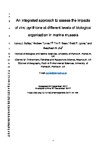An integrated approach to assess the impacts of zinc pyrithione at different levels of biological organization in marine mussels.
| dc.contributor.author | Dallas, LJ | |
| dc.contributor.author | Turner, Andrew | |
| dc.contributor.author | Bean, TP | |
| dc.contributor.author | Lyons, BP | |
| dc.contributor.author | Jha, Awadhesh | |
| dc.date.accessioned | 2018-02-26T17:23:15Z | |
| dc.date.available | 2018-02-26T17:23:15Z | |
| dc.date.issued | 2018-04 | |
| dc.identifier.issn | 0045-6535 | |
| dc.identifier.issn | 1879-1298 | |
| dc.identifier.uri | http://hdl.handle.net/10026.1/10858 | |
| dc.description.abstract |
The mechanisms of sublethal toxicity of the antifouling biocide, zinc pyrithione (ZnPT), have not been well-studied. This investigation demonstrates that 14-d sublethal exposure to ZnPT (0.2 or 2 μM, alongside inorganic Zn and sea water controls) is genotoxic to mussel haemocytes but suggests that this is not caused by oxidative DNA damage as no significant induction of oxidised purines was detected by Fpg-modified comet assay. More ecologically relevant endpoints, including decreased clearance rate (CR), cessation of attachment and decreased tolerance of stress on stress (SoS), also showed significant response to ZnPT exposure. Our integrated approach was underpinned by molecular analyses (qRT-PCR of stress-related genes, 2D gel electrophoresis of proteins) that indicated ZnPT causes a decrease in phosphoenolpyruvate carboxykinase (PEPCK) expression in mussel digestive glands, and that metallothionein genes are upregulated; PEPCK downregulation suggests that altered energy metabolism may also be related to the effects of ZnPT. Significant relationships were found between % tail DNA (comet assay) and all higher level responses (CR, attachment, SoS) in addition to PEPCK expression. Principal component analyses suggested that expression of selected genes described more variability within groups whereas % tail DNA reflected different ZnPT concentrations. | |
| dc.format.extent | 531-539 | |
| dc.format.medium | Print-Electronic | |
| dc.language | en | |
| dc.language.iso | en | |
| dc.publisher | Elsevier | |
| dc.subject | DNA damage | |
| dc.subject | Genotoxicity | |
| dc.subject | Marine mussels | |
| dc.subject | Sublethal toxicity | |
| dc.subject | Zinc pyrithione | |
| dc.title | An integrated approach to assess the impacts of zinc pyrithione at different levels of biological organization in marine mussels. | |
| dc.type | journal-article | |
| dc.type | Journal Article | |
| plymouth.author-url | https://www.ncbi.nlm.nih.gov/pubmed/29329085 | |
| plymouth.volume | 196 | |
| plymouth.publication-status | Published | |
| plymouth.journal | Chemosphere | |
| dc.identifier.doi | 10.1016/j.chemosphere.2017.12.144 | |
| plymouth.organisational-group | /Plymouth | |
| plymouth.organisational-group | /Plymouth/Admin Group - REF | |
| plymouth.organisational-group | /Plymouth/Admin Group - REF/REF Admin Group - FoSE | |
| plymouth.organisational-group | /Plymouth/Faculty of Science and Engineering | |
| plymouth.organisational-group | /Plymouth/Faculty of Science and Engineering/School of Biological and Marine Sciences | |
| plymouth.organisational-group | /Plymouth/Faculty of Science and Engineering/School of Geography, Earth and Environmental Sciences | |
| plymouth.organisational-group | /Plymouth/REF 2021 Researchers by UoA | |
| plymouth.organisational-group | /Plymouth/REF 2021 Researchers by UoA/UoA06 Agriculture, Veterinary and Food Science | |
| plymouth.organisational-group | /Plymouth/REF 2021 Researchers by UoA/UoA07 Earth Systems and Environmental Sciences | |
| plymouth.organisational-group | /Plymouth/Research Groups | |
| plymouth.organisational-group | /Plymouth/Research Groups/BEACh | |
| plymouth.organisational-group | /Plymouth/Research Groups/Marine Institute | |
| plymouth.organisational-group | /Plymouth/Users by role | |
| plymouth.organisational-group | /Plymouth/Users by role/Academics | |
| plymouth.organisational-group | /Plymouth/Users by role/Researchers in ResearchFish submission | |
| dc.publisher.place | England | |
| dcterms.dateAccepted | 2017-12-22 | |
| dc.rights.embargodate | 2018-12-27 | |
| dc.identifier.eissn | 1879-1298 | |
| dc.rights.embargoperiod | Not known | |
| rioxxterms.versionofrecord | 10.1016/j.chemosphere.2017.12.144 | |
| rioxxterms.licenseref.uri | http://www.rioxx.net/licenses/all-rights-reserved | |
| rioxxterms.licenseref.startdate | 2018-04 | |
| rioxxterms.type | Journal Article/Review |


